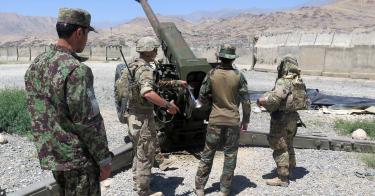While the White House and U.S. military commanders insist no decision has been made, Washington is alive with speculation that President Donald Trump intends to order the withdrawal of half of the 14,000 U.S. military personnel currently operating in Afghanistan.
The president, who has been critical of the Afghan war in the past, made an abrupt decision to withdraw all U.S. military personnel from Syria last month, so the threat of ordering a similar move in Afghanistan is not a hollow one. It would, however, be a mistake.
Each week, a new media outlet trots out a different statistic to show how the Taliban is either gaining ground, losing ground, or has fought the U.S. and Afghan government to a stalemate. The latter is probably the closest to the truth, but even that can be deceiving: A stalemate implies gridlock, but not parity.
As several of my Heritage Foundation colleagues recently explained, the Taliban can indeed operate freely in large parts of the rural countryside, but they only “control or influence” areas where 10.5 percent of the Afghan population lives. The government’s writ, meanwhile, extends to areas where 65 percent of the population lives. The rest is contested.
“This is not defeat. This is reality,” they argue. “We are there to help create a stable enough Afghanistan so it can manage its own internal security without the presence of tens of thousands of foreign troops helping it. Nothing more. Nothing less.”
That’s OK. The U.S. was never going to build a flourishing, modern, democratic society in Afghanistan by 2020. Our principal goal was to eliminate Afghanistan as a safe haven for terrorists to launch attacks against the U.S. In that endeavor, America has largely succeeded.
A second, important and related objective, was to build an Afghan government capable of sustaining itself and keeping the Taliban at bay. That project is a work in progress, but remains achievable.
But how? Can the U.S. really end the gridlock in Afghanistan?
I can’t answer that question, but I can tell you the Trump administration is finally doing the one thing I’ve long believed had the best chance at breaking the stalemate: applying real pressure on Pakistan.
American tolerance for Pakistan’s double game—harboring and supporting the Taliban, Haqqani Network, and other terrorist groups while taking billions of dollars in U.S. aid—came to an abrupt but overdue end this year. The Trump administration has suspended nearly all aid to Pakistan and adopted a much tougher line toward Islamabad at the International Monetary Fund and in international forums dealing with terrorism financing.
These moves are supported by a bipartisan consensus on Capitol Hill that’s gradually been souring on Pakistan in recent years. Whether this ultimately changes Pakistan’s calculus about backing the Taliban—a key condition for ending the war—is unclear, but it’s got a far better chance than showering Pakistan with more finger-wagging lectures and billions of dollars of U.S. taxpayer funds.
There’s another reason for some optimism. Last month, the Afghan government reshuffled its national security leadership, and that’s bad news for the Taliban. After years of failed attempts at extending olive branches to Islamabad and the Taliban leadership, President Ashraf Ghani has appointed a hardened former spy chief, Amrullah Saleh, as the new head of the interior ministry.
Saleh minced no words after his appointment, admitting to carrying a “deep and strong sense of revenge” and pledging to be “merciless” against Afghanistan’s enemies.
Another hardline former spy chief, Asadullah Khalid, was recently appointed acting defense minister. “We work for peace, but war also needs seriousness and self-assurance,” the Afghan president explained at the announcement ceremony. Meanwhile, Hamdullah Mohib, the extremely capable former Afghan ambassador to the U.S., was appointed national security advisor a few months ago.
In tandem, these appointments could produce a more determined and effective counterterrorism strategy by the Afghan government.
With the Afghan war now well into its second decade, the American electorate has understandably grown more pessimistic about the prospects of success. Yet it’s also important to recognize it is not among the top concerns of American voters—not even close. Domestic policy concerns consistently trump foreign policy by a wide margin, and in one July 2018 poll, only 58 percent of likely voters even knew the U.S. was still at war in Afghanistan.
Every businessman understands the importance of weighing the costs and benefits in a critical decision. With 14,000 troops in Afghanistan—most of which are training and mentoring the Afghan National Defense and Security Forces—the U.S. has suffered less than 20 casualties annually in each of the last three years. The financial cost, meanwhile, was roughly $45 billion in 2018, most of which was devoted to logistical support.
That’s less than half of the more than $100 billion per year spent at the height of the war, when America had roughly 100,000 troops in the country.
The financial and human costs are significant, and for those families that have lost a loved one, unfathomable. They must be measured, however, not just against the direct benefits they provide, but against the cost of the alternatives. And that’s where the picture turns more bleak.
Without the support of the U.S., it’s unlikely the Afghan government could sustain itself. The Trump administration should continue pressing allies and international partners to contribute more to the effort in Afghanistan. However, removing the keystone from an already-shaky foundation is a potential recipe for disaster.
At a relatively reasonable cost, America can continue serving as a hyper force multiplier in Afghanistan, where even basic U.S. intelligence and logistics support can turn the tide of a battle against the Taliban. “A training mission coupled with a high-end special operations mission is something the U.S. does in countless countries around the world,” note my Heritage colleagues.
That’s true, and perhaps nowhere else are the stakes higher or the impact of U.S. support more decisive than in Afghanistan.
This piece originally appeared in The Daily Signal




